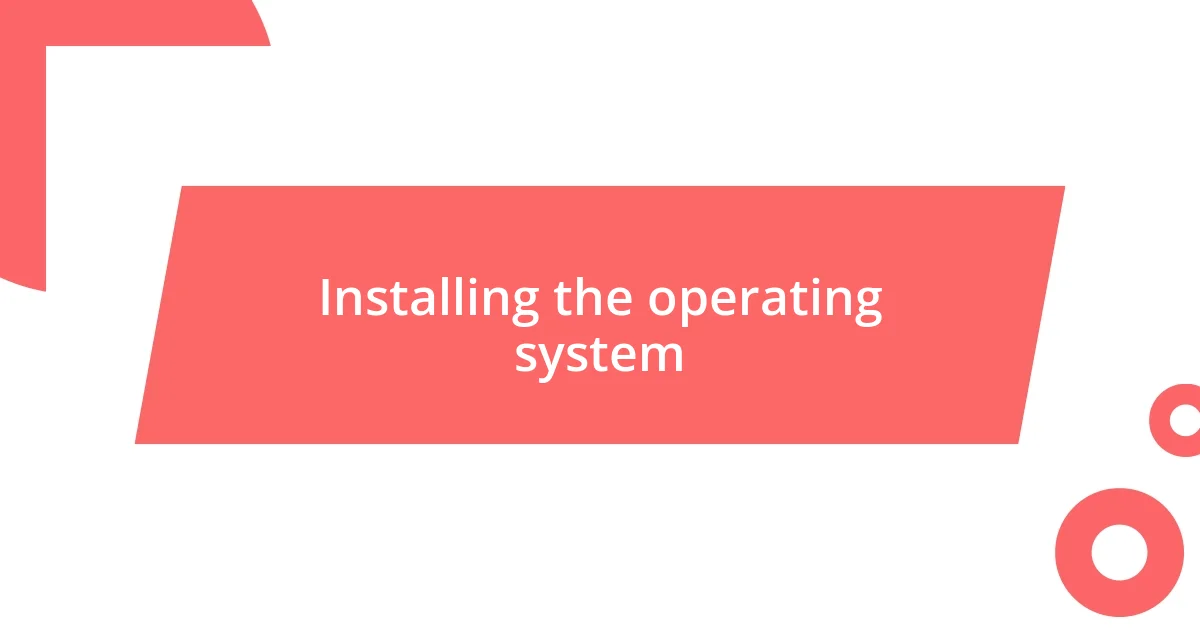Key takeaways:
- Choosing compatible components is crucial for optimal performance, with emphasis on balancing CPU and GPU strength.
- Understanding personal gaming preferences and future-proofing the setup significantly influences component selection.
- Optimizing performance settings and keeping drivers updated can enhance the gaming experience substantially, leading to smoother gameplay.

Choosing the right components
When I set out to build my perfect gaming PC, I realized that choosing the right components is almost like assembling a puzzle. Each piece needs to fit just right, which involves understanding how things like the CPU, GPU, and motherboard work together. I remember the moment I found the perfect GPU; it felt like a mini-victory, knowing that it would elevate my gaming experience to a whole new level.
One thing I learned through trial and error is that compatibility is crucial. Did you know that a powerful CPU could be bottlenecked by a weaker GPU? I had that experience, and it taught me to carefully check compatibility lists before making any purchases. It can be frustrating to realize your dream setup can’t deliver its potential just because of mismatched components.
Moreover, I believe in investing a bit more in components that are critical to performance. I opted for a high-quality power supply and cooling system, which initially felt like overkill. But now, every time I boot up my PC and hear the quiet hum of the fans, I remember how those choices have paid off, ensuring stability and longevity for my build. Wouldn’t you want your PC to last through countless gaming marathons?

Understanding your gaming needs
Understanding your gaming needs is an essential first step before diving into the specifics of building your PC. I remember sifting through dozens of gaming titles, realizing that my preferences leaned heavily toward graphics-intensive games, which spurred my search for a high-end GPU. Each genre can demand different specifications, and understanding what truly excites you in gaming can shape your choices significantly.
For instance, if you’re mostly into competitive gaming, a faster refresh rate and a powerful CPU could get you that elusive edge over your opponents. I had a moment of clarity during a particularly intense match when I realized that lag clearly resulted from underestimating my CPU’s capabilities. On the flip side, story-driven single-player games might have you placing more importance on a high-resolution display for that immersive experience.
It’s also vital to consider your long-term gaming aspirations; I often think about future-proofing my setup. When I purchased my components, I didn’t just think about what was popular at the time, but also what could handle upcoming titles. This foresight allowed me to enjoy newer releases without the frustration of needing an upgrade so soon after building my PC. The investment became less about immediate gratification and more about anticipating my gaming evolution.
| Gaming Focus | Recommended Component |
|---|---|
| Competitive Gaming | High-refresh-rate Monitor, Powerful CPU |
| Graphics-intensive Games | High-end GPU, Excellent Cooling |
| Story-driven Adventures | High-resolution Display, Quality Audio |
| Future-proofing | Upgradable Components |

Budgeting for your gaming PC
When it comes to budgeting for your gaming PC, I’ve learned that it’s essential to strike a balance between quality and cost. I remember feeling overwhelmed when I first created my budget; it seemed like the sky was the limit in terms of spending. However, setting a defined budget helped me prioritize components and make informed choices without breaking the bank. It was a relief to realize that I didn’t have to buy the highest-end parts to enjoy a fantastic gaming experience.
To make budgeting more manageable, here are some tips I found helpful:
- Prioritize Essential Components: Focus on parts that will impact gaming performance the most, such as the GPU and CPU.
- Do Your Research: Look for reviews and benchmarks to see which components give the best performance for your money.
- Set Aside a Buffer: Always allocate a little extra in your budget for unexpected costs, like additional cooling or accessories.
- Consider Refurbished or Second-hand Options: Sometimes you can find great deals, and I scored a fantastic GPU this way without compromising on quality.
- Plan for Upgrades: Think about future needs and consider components that are upgradable; it can save you money down the line.
By keeping these considerations in mind, I was able to construct a solid gaming rig that not only met my current needs but also had room for growth and improvement.

Assembling your gaming PC
Assembling your gaming PC is where the excitement really begins. I still recall the moment when I slid the motherboard into the case, and that sensation of anticipation hit me. It’s fascinating how all these individual parts, from the CPU to the GPU, come together to form a well-oiled machine. But trust me, putting everything together can be daunting. Before starting, I laid out all my components and manuals, which really helped make the process smoother.
One of the most critical steps is ensuring that you’re grounded to prevent static electricity from frying your components. Something as simple as wearing an anti-static wrist strap can be a game changer. I made the mistake of forgetting this during my first build, and I can’t express how nerve-wracking it was to see my parts spark a little when I touched them. Once you get past these initial jitters, it’s about connecting cables and ensuring everything fits snugly. Don’t be afraid to take your time; I often double-checked connections to avoid any future hiccups.
When it came to adding my cooling system, I felt a blend of determination and excitement. I opted for a liquid cooling solution, which I had heard could be a bit more complex, but seeing it in action during a gaming session was worth the effort. I often think, what’s more exhilarating than knowing you’ve crafted something uniquely tailored to your gaming style? As I fired up my rig for the first time, the rush of satisfaction was unparalleled. How do you think building your own PC would feel? You might be surprised at how personal this experience becomes.

Installing the operating system
When it came time to install the operating system, I felt a mix of excitement and nervousness. It’s that pivotal moment when your meticulously built machine can finally come to life. I remember sitting at my desk, USB flash drive in hand, and thinking, “This is it! All my hard work is about to pay off.” I plugged in the drive and booted up the PC, watching the BIOS screen flash by; it felt surreal seeing my custom machine respond.
Choosing between Windows and other operating systems is an important decision. For me, Windows was the go-to due to its extensive compatibility with games and software. I followed the straightforward steps in the installation process, clicking through menus and selecting partitions. I can’t help but smile at how satisfying it was to watch the progress bar fill up; each percentage point felt like a victory. Of course, I made sure to have all my drivers ready, something that saved me from a headache later on. Have you ever struggled to find the right driver after an install? That chaos can really take the joy out of your new setup.
Once the OS was up and running, the real fun began—customizing it to fit my preferences. From tweaking settings to installing my favorite games, it felt like transforming a blank canvas into a vibrant masterpiece. I can’t tell you how elated I was when I finally clicked on my first game, the anticipation building as it loaded. That moment, when everything came together, confirmed that every minute of research and assembly was worth it. How does the thought of customizing your own OS resonate with you? For me, it added a personal touch that made my gaming experience truly one-of-a-kind.

Optimizing performance settings
Optimizing performance settings is crucial to unlocking the full potential of your gaming PC. I remember the first time I dove into the settings menu; it felt like being a kid in a candy store. The ability to tweak graphics, refresh rates, and resolution settings was exhilarating. For instance, adjusting the frame rate limit helped smooth the gameplay without taxing my GPU too much, which is something I’ve come to appreciate during marathon gaming sessions.
One tip that transformed my experience was using the in-game settings wiseley. Initially, I didn’t realize the impact of lowering shadow quality or turning off motion blur. However, after experimenting, I noticed a significant boost in frame rates, and honestly, it brought a huge smile to my face when I could finally run my favorite game at max settings without stuttering. Have you tried tinkering with these settings yet? You might be surprised by how much of a difference it makes—like unearthing hidden gems in your own setup.
Another crucial aspect I’ve learned is the importance of keeping drivers updated. The first time I faced stuttering while gaming, it led me on a stress-filled hunt to find a solution. I eventually updated my graphics drivers, and the difference was night and day—it felt like I had just upgraded my entire system! This experience taught me that sometimes, the smallest adjustments can yield the most significant improvements. So, don’t overlook those updates; they could be the key to making your gaming experience smoother and more enjoyable. What’s your go-to strategy for keeping performance high? I’d love to hear your approach!















